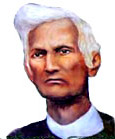 Fakir Mohan Senapati (1843-1918) lived during tumultuous times. Orissa was taken over by the British in 1803, and was soon thereafter incorporated into a transnational economic system. Senapati`s consciousness of being an Oriya developed in a politicized context where an Oriya cultural identity (like many other minority identities in history) was at risk of disappearing. What drove him was less a desire for literary fame than the need to save and protect the language of the people around him.
Fakir Mohan Senapati (1843-1918) lived during tumultuous times. Orissa was taken over by the British in 1803, and was soon thereafter incorporated into a transnational economic system. Senapati`s consciousness of being an Oriya developed in a politicized context where an Oriya cultural identity (like many other minority identities in history) was at risk of disappearing. What drove him was less a desire for literary fame than the need to save and protect the language of the people around him.
There was a measure of idealism that inspired him, no doubt, but Senapati had a very clear idea of the strategic interests of the various groups at stake. He understood clearly that the future of at least the Oriya middle-class was bleak if Bengali instead of Oriya became the official medium of communication in Orissa. Senapati`s concern with language as a social force - its seductive power, its authority, its abuses - clearly grew out of the struggles into which he had been thrust early in his life, the struggles to defend and save a language and a culture.
Fakir Mohan Senapati was intellectually restless and adventurous, and had the spirit of a reformer more than that of a writer in search of literary fame. He grew up in a part of colonial India that barely registered in the consciousness of the Viceroys and their officials. But it is from this particular vantage point that he created a unique synthesis of the traditional and the contemporary, a synthesis whose power and example are relevant even today. Senapati`s critique was never merely negative; it was based on a vision of human equality and cultural diversity, of a radical humanism that was fed by a variety of religious traditions.
Fakir Mohan`s sense of humor and irony have remained unsurpassed in Oriya literature and it is his characteristic style which made him popular with a wide range of readers. He believed that Faith, Asceticism, Love and Devotion were four pillars that formed the base of "Dharma". His faith was derived from Islam, asceticism from Buddhism, love from Christianity and devotion from Vaishnavism.
Fakir Mohan completely discarded the traditional theme of romantic love between prince-princesses and wrote about common people and their problems in his novels. In contrast to the Sanskritised style of his contemporaries, he also used colloquial idiomatic Oriya in his writings with great skill and competence. If the works of earlier novelists seemed like prose renderings of medieval kavyas, Fakir Mohan`s novels were realistic to the core. He can be favorably compared with 20th century novelists like Premchand and Bibhutibhusan Banerjee.
Fakir Mohan is considered as the greatest prose writer in Oriya literature. But it is amazing to note that he hardly wrote any prose until he retired from administrative service. He translated Ramayana, Mahabharata and some of the Upanishads from the original Sanskrit for which he is popularly known as "Vyasa Kavi". He wrote poetry too, but the themes of his poems were not considered conventionally fit material for poetry. He used colloquial, spoken and rugged language of the common man, which no poet in Oriya had done for centuries. Fakir Mohan wrote four novels, two volumes of short stories and one autobiography. Besides that, he mastered the art of writing short stories for which he is also termed as Katha Samrat (Emperor of Shortstories) in Oriya literature.



















